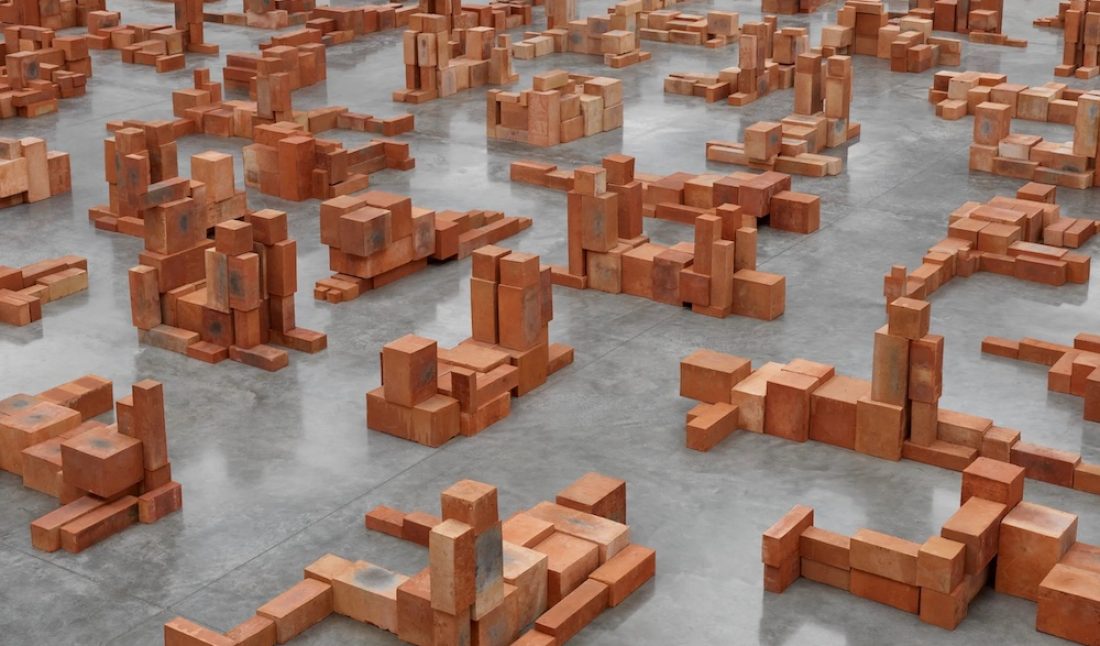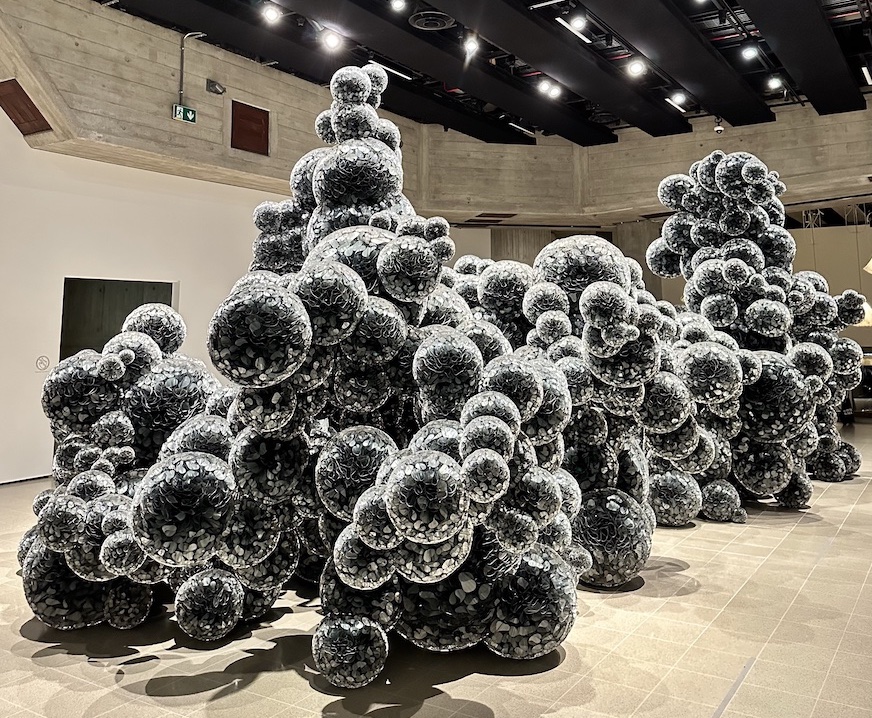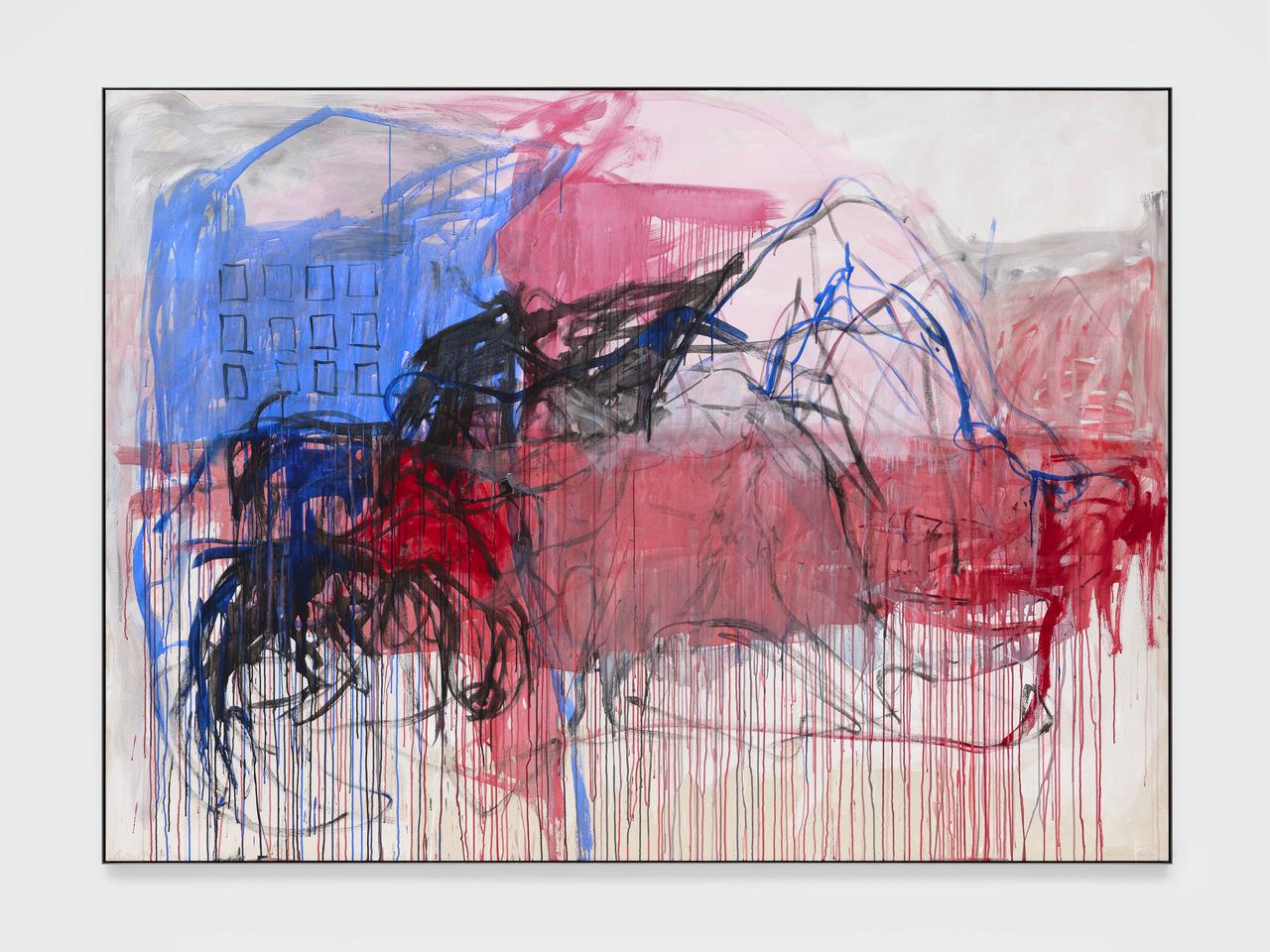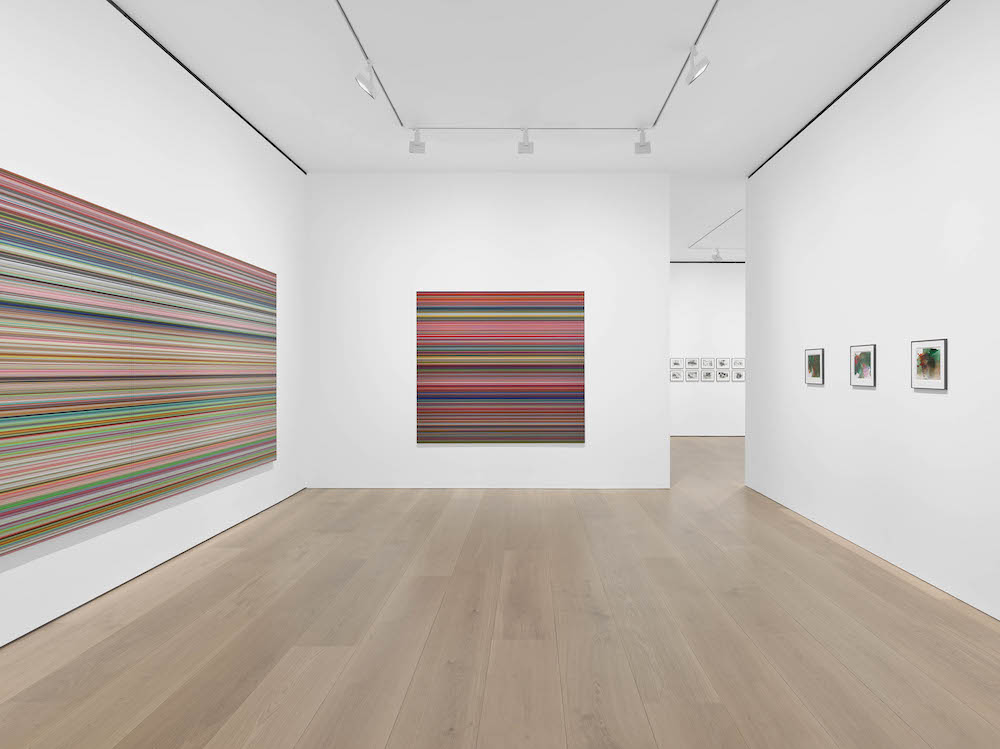In a convergence of sculptural finesse and intellectual inquiry, Antony Gormley‘s exhibition, “Body Politic,” (on view through January 28) at White Cube in London emerges as a testament to the symbiotic relationship between artistic expression and existential contemplation. Across the confines of this gallery space and within five distinct bodies of work, Gormley intricately dissects the corporeal and societal dimensions of human existence, employing the medium of sculpture as a nuanced discourse on urban dynamics.
The excellently curated collection unfolds as a visual treatise, inviting the audience to engage with its layered exploration of form, space, and the intricate interplay between the individual and the urban milieu. As we immerse ourselves in the transcendent realms of Gormley‘s oeuvre, this article endeavors to dissect the intellectual tapestry woven within ‘Body Politic,’ deciphering its philosophical resonances and sculptural lexicon.
Antony Gormley Celebrates Freedom within the Body
Serving as the backbone of the exhibition, a linear procession of eight concrete sculptures defines a trajectory from the courtyard through the gallery’s corridor. Envisioned by Gormley as “intimate bunkers for one,” each iteration of “Retreat”(2022–23) is carefully cast to match the scale of the artist’s body, utilizing a 55 mm thick reinforced concrete. These sculptures collectively consolidate, structure, and encapsulate a spectrum of body postures—ranging from balanced to compressed and tensioned forms. Delicate square orifices strategically positioned at the mouth area provide visual access to a body-sized void within.
Gormley contends, “The only place where we can find true freedom is within the infinite darkness of the body available to us once the body is still. These works simultaneously evoke and embody the space that envelops us the moment we close our eyes. I consider this the most pertinent and potent space of personal freedom, and these works ardently celebrate it.”
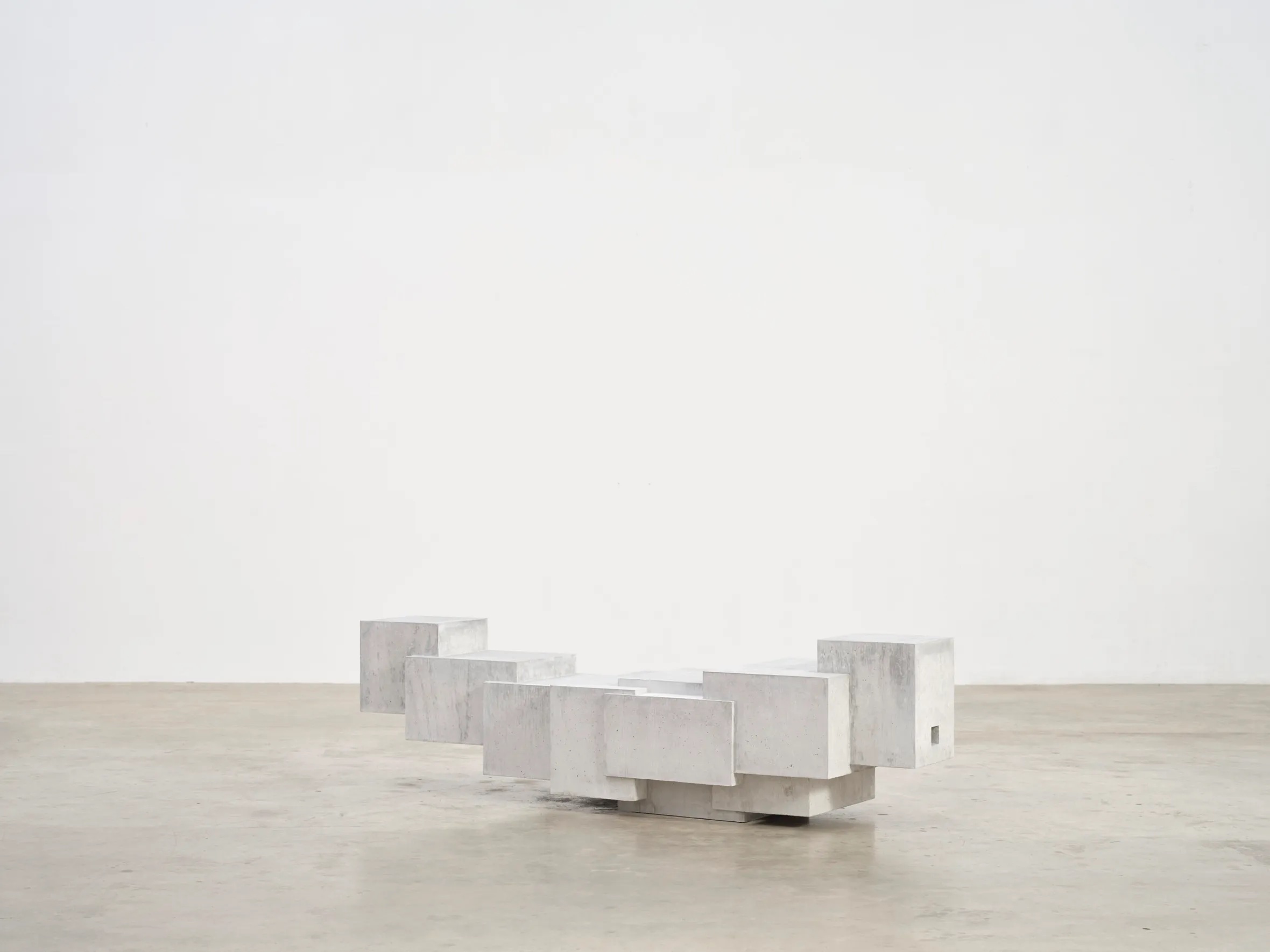 Antony Gormley, “Retreat,” 2022-23, © White Cube.
Antony Gormley, “Retreat,” 2022-23, © White Cube.
Delving deeper into the concept, Gormley asserts that, from his perspective, the mouth serves as an aperture granting access to the dark interior while also being a point of communication and contact. The bunkers can be seen as an expression of the selfishness of liberal economics, yet Gormley suggests they are a vehicle for expressing the idea that true freedom requires imaginative freedom, achievable only through stillness and an acceptance of our condition of embodied time. The bunker works, according to Gormley, navigate the extraordinary paradox that the mind can only be free when the body is stilled.
Gormley’s sculptural narrative unfolds with a dual invitation, presenting two distinct avenues for viewer engagement. The first beckons through a pathway of “recognition” and imaginative immersion into the object—embodied by life-size body cases and forms, encapsulating the profound darkness within the body as an “objective correlative.” Conversely, the second avenue encourages active, bodily participation. As early as 1994, Gormley articulated his rejection of the absolute division between viewer and art space, expressing a desire for a more immersive field of experience.
“Body Politic” Invites Viewers to Actively Engage
This conceptual framework resonates with the reciprocal relationship among the object, the exhibition space, and the entering viewer. A reflection on sculptural practices of the 1960s, pivotal to Gormley’s artistic evolution, surfaces. Drawing inspiration from the installations of Donald Judd, Robert Morris, Bruce Nauman, and others, Gormley aligns with the notion of a “sited vision.” This ideology implicates the viewer’s presence as a moving body amid the artworks, regardless of the direct reference to the human body within the objects themselves. In this artistic lineage, “Body Politic” becomes a contemporary exploration, inviting participants to transcend mere observation and actively engage in the symbiotic dance between object, space, and self.
Anchored within the expansive South Gallery II, Antony Gormley’s “Resting Place” (2023) unfolds as a grounded counterpart to “Retreat,” summoning a dense urban landscape. This remarkable installation comprises 244 body-forms crafted from fired clay blocks, forming a labyrinthine terrain. The viewer is invited to navigate this maze of bodies at rest, each figure occupying various postures—prone, splayed, fetal—creating a nuanced commentary on diverse human conditions. The spacing between these forms offers just enough room for passage, evoking poignant scenarios, from the abandonment of bodies on the beach to the struggles of those displaced by conflicts, climate crises or resource scarcity.
Central to the essence of “Resting Place” is the meticulous processing of clay—a crucial aspect emphasized by Gormley. Extracted from a valley bottom in Gloucestershire with a geological history spanning millions of years, the clay’s stratification holds a tangible connection to time. However, Gormley draws attention to the disruptive nature of historical extraction practices, contrasting the mechanically processed substance used in “Resting Place’”with the hand-thrown clay employed in the “Field” works.
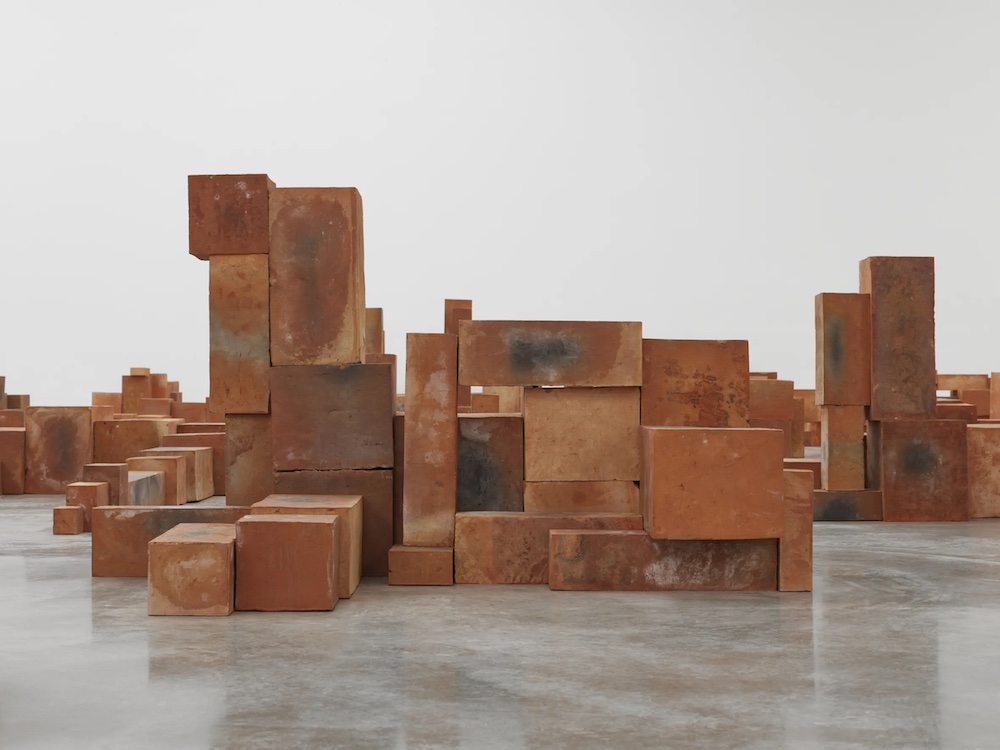 Antony Gormley, “Resting Place,” 2023, © White Cube.
Antony Gormley, “Resting Place,” 2023, © White Cube.
Examining the trajectory of cities and urbanism, Gormley draws parallels between the enduring presence of bricked and fired earth and the rise of the first cities in Mesopotamia’s Uruk during the late 4th millennium BCE. This exploration extends to the elemental significance of iron and the Industrial Revolution, emphasizing the lasting influence of these historical epochs on the human experience. “Resting Place” thus becomes a profound exploration, weaving together human history, industrial legacy, and the intricate interplay between self and environment.
In the North Gallery, Antony Gormley unveils a captivating series of six “Weave Works” laboriously crafted to map the human body’s volume. These sculptures, cast from orthogonal, latticed cast iron bars and exposed to the elements, create a mesmerizing interplay of space and light. Their rusty exteriors allow for the passage of light, fostering an illusion of shifting density that elegantly transcends traditional sculptural boundaries, seamlessly merging with the architectural space.
A departure from conventional freestanding sculptures, three of the works in “Test” (2021–23) diverge from the norm. Positioned against the gallery walls, while the remaining three touch them, these sculptures intentionally implicate the room as an integral part of the artistic narrative. Visitors, in turn, become acutely aware of their position within the space, fostering a dynamic interaction between the artworks and the observer’s movement.
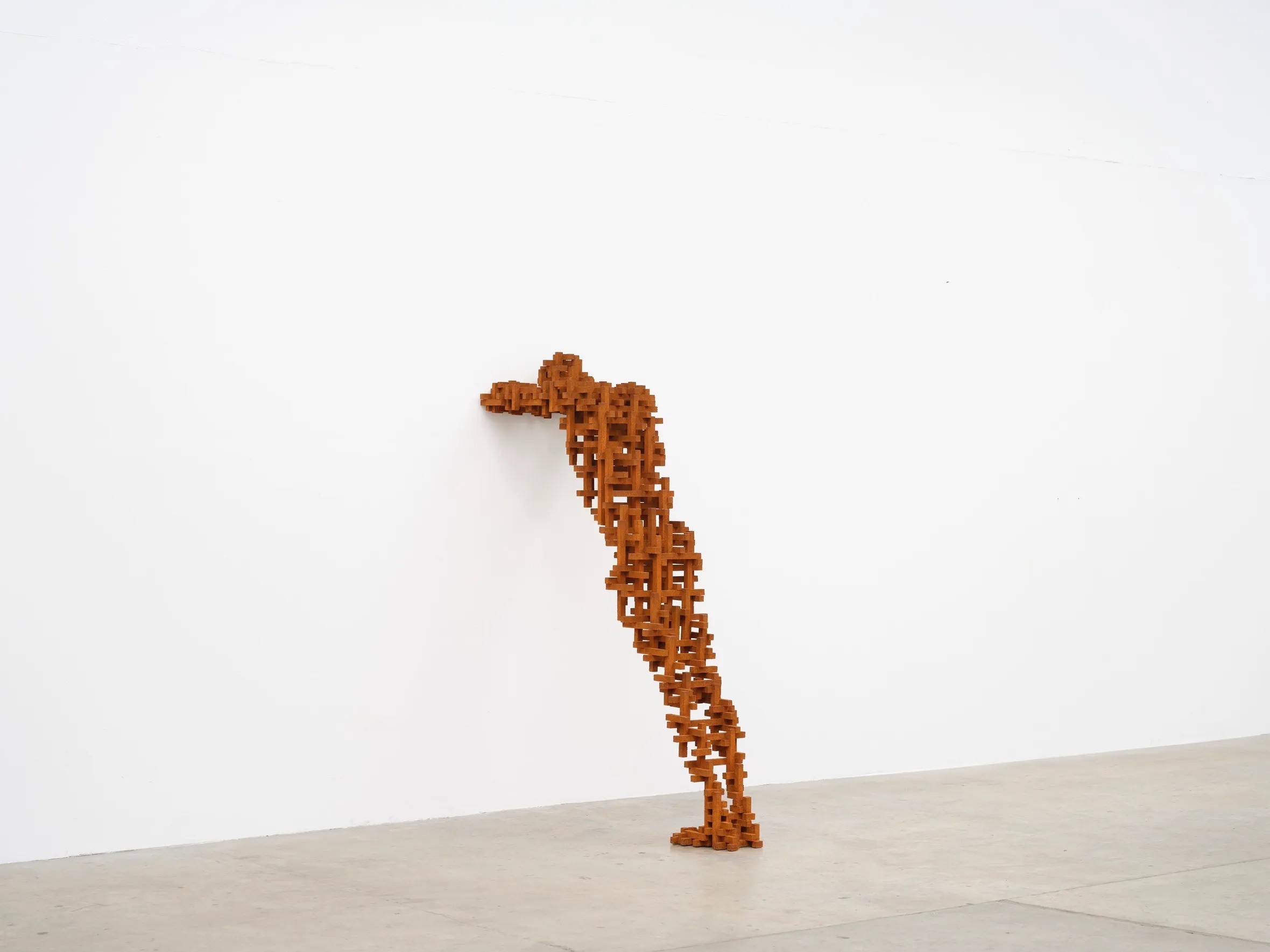 Antony Gormley, “Weave Works,” 2021-23, © White Cube.
Antony Gormley, “Weave Works,” 2021-23, © White Cube.
Employing an Innovative Method in “Weave Works”
Gormley’s execution of the “Weave Works” involves the innovative lost foam method, enabling the creation of intricate castings that surpass the limitations of traditional lost wax processes. This technique harnesses the self-organizing principles of vibrated sand, essential for realizing the complexity inherent in the woven structures. The alchemical transformation from lightweight polystyrene to the solid mass of iron, achieved through melting recycled steel from automotive brake discs at 1400 degrees, exemplifies the extraordinary processes at play in Gormley’s artistic endeavors.
Acknowledging the expertise of the team at Hexham, “Weave Works” emerges as skeletons confronting the underpinnings of our architectural context. These sculptures engage with the surrounding walls, floor, and pillars, encouraging viewers to reflect on their positioning within these conditioned spaces. They serve as aesthetic entities and provocations, prompting observers to confront and recognize their symbiotic relationship with the constructed world. Through “Weave Works,” Gormley offers a profound commentary on the human experience within the built environment, transcending traditional sculpture to create an immersive dialogue between art and space.
Within the setting of South Gallery I, three substantial ribbons of rolled black steel extend seamlessly from the floor, ceiling, and walls. Converging at the room’s center, they intricately weave a body zone, forming a labyrinth of tangled orthogonal lines that engage both with and within the architectural framework. Much like the dynamic interplay observed in “Test,” “Bind” (2023) emerges as a captivating dialogue, where the artwork both activates and is activated by the surrounding space. This seamless transition underscores the interconnected themes of Gormley’s exploration of the built environment and the dynamic relationships between art and space in his “Body Politic” exhibition.
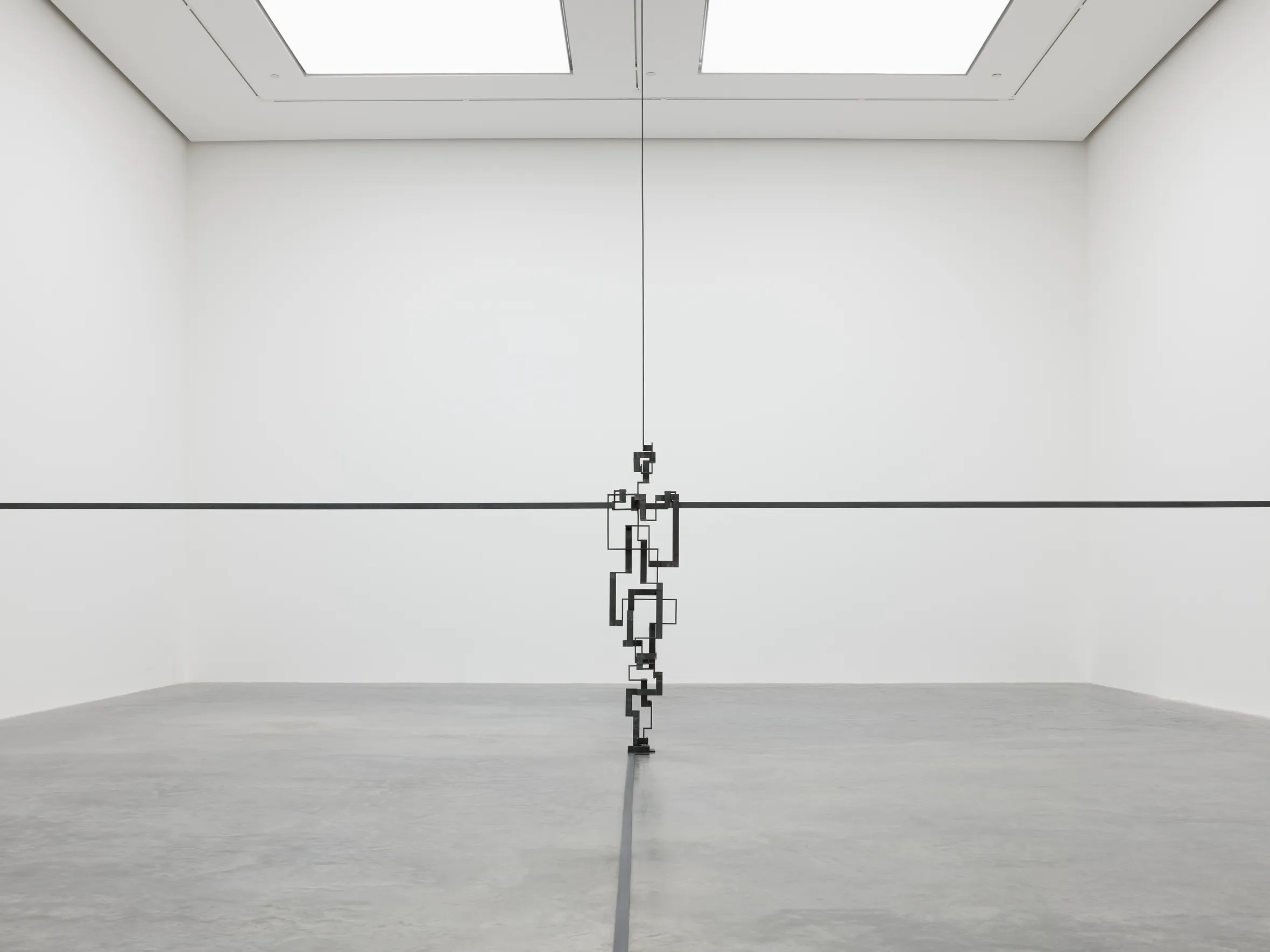 Antony Gormley, “Bind” 2023, © White Cube.
Antony Gormley, “Bind” 2023, © White Cube.
Continuing this exploration, in “Bind,” five high-tensile lines traverse the spatial expanse, now transformed into carriers for the mapping of a body. This sculptural endeavor delves into paradoxes, inviting contemplation reminiscent of a crucifixion. Gormley argues cross existed within the human form long before anyone was affixed to it. The enduring relationship between sexuality and intelligence, coupled with our capacity, through extended limbs, to embrace space, becomes a central theme. The work embodies a clear manifestation of accepting the collective responsibility of shaping the world that, in turn, shapes us.
The rules governing verticality and horizontality within the confines of the room are transposed onto the represented body, resulting in the annihilation of insides and outsides. This deliberate fusion prompts an awakening to personal freedoms, movement, and trajectory through the dimensions of space and time. Each object’s significance lies dormant until animated by the viewer’s attention, fostering a shared ground where the sculpture and observer collaboratively generate meaning.
In the realm of sculpture, an art form resonating with silent stillness amid a world brimming with diverse stimuli, Gormley’s creations, particularly as they evolve toward geometric abstraction and centralization, serve as vessels for the projection of emotions and empathy. As these works persist in their resolute existence on shared ground, the synergy between viewer and sculpture becomes paramount, offering a transformative experience where stillness and silence invite the viewer’s movement and introspection. The evolving geometric and abstract nature of Gormley’s art beckons viewers to project their own embodied memories onto the sculptural space. These contribute to the perpetual dialogue between the observer and the art.
“The greater responsibility of the art of our time is to somehow reflect on and provide instruments for examination and self-awareness.” — Antony Gormley
The culminating piece, “Stand” (2023), standing proudly as a towering structure meticulously crafted from Corten steel beams. Arranged in a Jenga-like formation, it reaches an impressive height of nearly five meters, embracing the dialogue of three coordinates at scale. This sculpture symbolizes the entropy inherent in its construction and acknowledges the vulnerability of all human-made creations. The use of gas-cut Corten is scrupulous, with 115-mil square beams carefully milled and bolted together using interleaved plates—a meticulous engineering feat that underscores an audit of our current state.
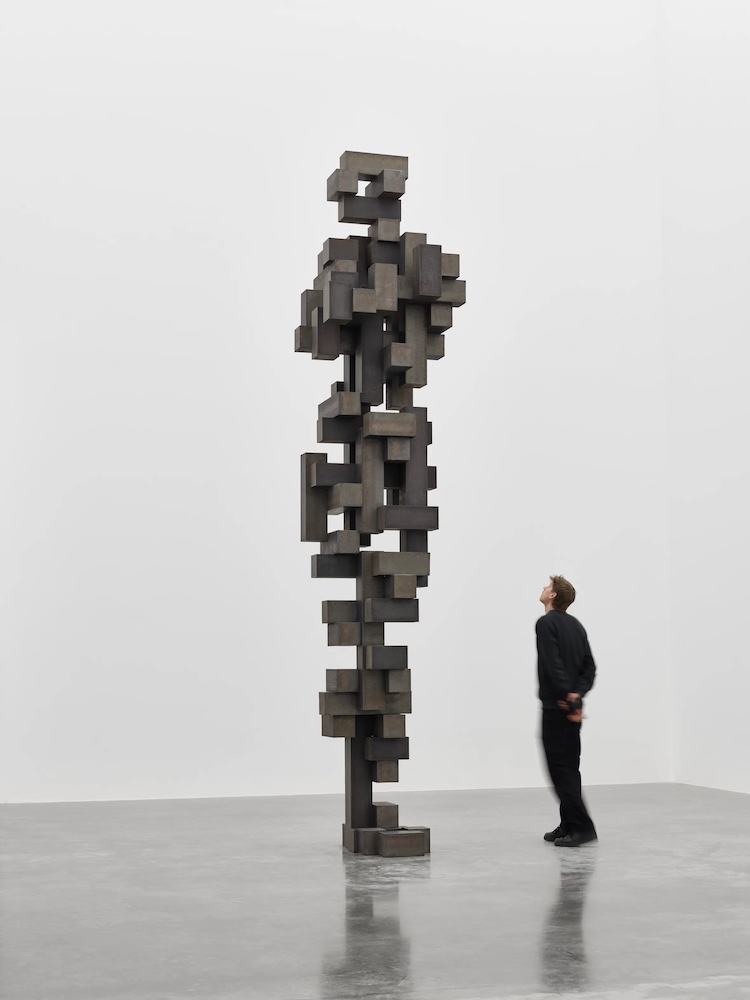 Antony Gormley, “Stand,” 2023, © White Cube.
Antony Gormley, “Stand,” 2023, © White Cube.
Gormley emphasizes the significance of utilizing public realm methods and engineering to create imaginative objects. “Stand” (2023) is a manifestation of this approach, engaging with the world we inhabit, the materials we depend upon, and the means of manufacture that shape our environment. More precisely, this sculpture exhibits a duality: a robust determination embodied in its engineering and an acknowledgment of its potential jeopardy, symbolized by the inherent possibility of its fall.
Gormley’s reflections on “Stand” (2023) prompt contemplation on the very nature of monuments. While monuments traditionally serve as memorials to past events, “Stand” (2023) diverges from this convention. It interrogates the language of monumentality and questions the inherent right of a statue to stand and represent something. Unlike “Angel of the North” (1998), which marked the transition from the industrial to the information age, “Stand” (2023) peers toward the future, gazing beyond the horizon, challenging our perception of statues and their roles in the contemporary landscape.
As “Body Politic” weaves its narrative between sanctuary and control, freedom and discipline, it beckons visitors to embrace the intrinsic qualities of sculpture—silence, stillness, and materiality. These elements serve as conduits for heightened self-awareness, prompting contemplation of personal freedoms in movement and thought within the exhibit’s immersive space.
In Antony Gormley’s own words, “The greater responsibility of the art of our time is to somehow reflect on and provide instruments for examination and self-awareness.” From the earliest works like “Sleeping Place” to “Man Asleep” and “Another Place,” Gormley’s concerns have traversed the essential themes of human existence. The shifting landscapes, from individuals sleeping on the streets to urban migrations, resonate with the evolving human condition. The collective body, once envisioned in the context of forest-dwelling hunter-gatherers, is now redefined against the backdrop of urbanity—a reflection on our condition as urban animals, embodying Gormley’s enduring exploration of boundaries and progress.






